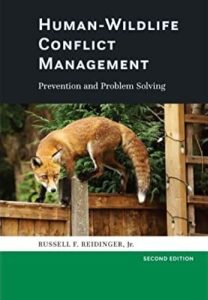 Deer eating the bedding plant flowers? Bears tipping over the rubbish bins? Squirrels taking up residence in the attic? These are only a few of the common but reasonably innocuous examples of human-wildlife conflict that many of us have, do, or will experience in our lifetimes. Others – perhaps a Cougar stalking the local joggers or elephants destroying the village’s farm fields – are a bit less common but far more dangerous to all involved parties, human and non-human alike. Yet whether they be nuisances or objective threats to life and limb, all of these are within the scope of study for those interested in better understanding and managing conflicts between humans and wildlife.
Deer eating the bedding plant flowers? Bears tipping over the rubbish bins? Squirrels taking up residence in the attic? These are only a few of the common but reasonably innocuous examples of human-wildlife conflict that many of us have, do, or will experience in our lifetimes. Others – perhaps a Cougar stalking the local joggers or elephants destroying the village’s farm fields – are a bit less common but far more dangerous to all involved parties, human and non-human alike. Yet whether they be nuisances or objective threats to life and limb, all of these are within the scope of study for those interested in better understanding and managing conflicts between humans and wildlife.
Dr. Russell F. Reidinger Jr. has spent decades researching and teaching about the dynamics that come into play when human and non-human animals come into conflict. You could even say he has written the book on the subject. It was published in 2013 and titled Wildlife Damage Management: Prevention, Problem Solving, and Conflict Resolution. Since that time, much has been discovered about why and what happens when humans and non-human animals come meet in areas where they are both seeking to live. In fact, there is so much new information that has led to the re-thinking of how such interactions are understood that new edition of this book was needed.
Thus just this past October, Johns Hopkins University Press published a new second edition to Dr. Reidinger’s book. Titled Human-Wildlife Conflict Management, this new edition presents readers with a vast body of newly updated knowledge as well as a newly enlarged perspective of just what can be included in this area of wildlife science, such as the inclusion of invertebrates, fish, and plants.
While this book is written for those presently working in the field of wildlife science or studying to do so (for which it should be considered required reading), it is a remarkably readable book that addresses a subject that is increasingly affecting more and more people as we humans continue to expand our living and recreational spaces into areas that were previously largely left to our non-human relations, as well as modifying our living environments to be more enticing to those non-human animals with a particularly opportunistic streak. Therefore, it is a book that anyone seeking to improve their knowledge of the subject should consider adding to their to-be-read list.
